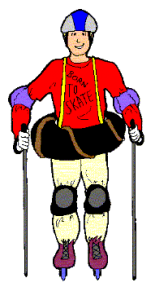Eighteen years ago as I was writing the early chapters of my book, Get Rolling, the Beginner’s Guide to Inline Skating, I had already forgotten that it took about 20 hours of practice before I was finally able to skate without feeling like a klutz. Once my tentative, awkward, uncoordinated days were behind me, all I could think of as I wrote my book was:
Wow! Anybody who can walk can skate! I need to tell the world about this!
And that is when I became a certified instructor and began offering skating lessons to demystify the sport for adults.
Reality check
Despite my invariably encouraging words and practice tips to every one of my beginning students for nearly 20 years, I am now ready to admit that inline skating is decidedly not for everybody.
Ten-plus years ago, I was teaching fairly athletic people who came to me primarily for braking tips. But today’s typical beginners come to their first lesson with less balance, coordination and fitness. I am not sure why this is so, unless it’s due to broader cultural awareness and acceptance of the sport overall.
And then there is the subject of fitness. On my FAQ page I try to set very clear expectations for two types of beginners. See myanswers to:
I used to think that this expansion of the sport to a wider base of participants was a good thing, but now I have concerns. I am beginning to suspect that I have probably empowered more than a few of my students with just enough skill and confidence to go out and get injured through skating—the exact opposite of my goals as a certified instructor!
The blessed few
Over my 20 years of teaching, I have seen one or two successes among those who started from zero aptitude. I fondly remember one fairly fit, normal sized gal who continued to tremble and freeze with fear even after dozens of lessons. She finally achieved her dream of skating on a flat sidewalk (and became a close friend)—after three years and five trips to Camp Rollerblade, totaling over 100 total hours of instruction.
Skaters’ aids
Because I like to support inventors who are trying to make the sport safer for more participants, I have tested many skating aids. I have been disappointed to find that many of these hide or totally remove a key element of the joy of skating: skaters would be carrying a broom, gripping a pair of handbrakes attached to cords running up the legs, experiencing dragging wheels when tipped a certain way or in reverse. This is not the skating freedom that inspires people to dream of joining the sport!*
Recently I was testing yet another invention for skaters with special needs when I stopped to chat with a couple who’d observed me as I rolled by. The woman was my typical student’s age. She made this point and it hit home: “You know, there are a lot of other enjoyable outdoors activities a person can do with a lot less risk of falling. Why not choose one of those?”
Safer alternatives
For those who can’t bear to give up the dream of skating, I suggest sticking to the safety of indoors rinks where there are walls, carpets, benches to rest on and no automobiles.
* The one invention I continue to eagerly support is the 4Xs cuff-activated brake. I am still convinced by my testing that this system offers the safest and most effective stopping power available today. (Fingers crossed for entry-level models scheduled for release in spring of 2012!)Tags: alternatives, Opinion, rollerblading

Hi there,
Interesting post. As a skiing instructor and learning consultant, I agree that some people arrive at lessons with more baggage than others that affects their progress in learning. That said, barring physical/mental disabilities and individuals lacking the bone density to safely survive a fall, I believe anyone can learn to skate.
Learners on the low end of the athleticism and learning absorption scale definitely need instructors with:
– sharper assessment skills
– excellent ability to select development activities
– excellent ability to guide practice
– attention to and ability to resolve psychological factors (fear, motivation)
Instructors tend to develop these skills by achieving higher levels of certification.
It’s also important for the instructor to set expectations: instead of expecting the learner to be able to do a v-walk and a-frame turns by the end of the beginner lesson, maybe the instructor should expect the learner to be able to do moves on the grass.
That said, I’ve seen firsthand that given the right instruction, any able-bodied motivated person can eventually achieve some competency in skating.
David, so nice of you to provide an upbeat reply! My enthusiasm to help every beginner at every starting level did not waver for years. Maybe I just need to go back to my belief that they leave my care smart enough to stay out of danger when they practice on their own. Or maybe it’s time for me to get a fresh outlook during the upcoming ski season!
hw are you all doing ? hope you all doing great in Jesus ..name.. AMEN
well is been a long time since i have not heard from Liz miller and i want to know how she is doing and i thank her so much for seeding me and my team..and friends with the books ..it has help us a lot ….thanks…Liz
Nice to hear from you, Paul.
Happy New Year and keep rolling!